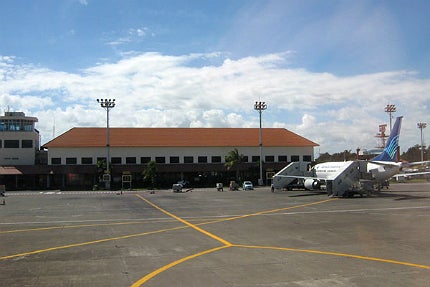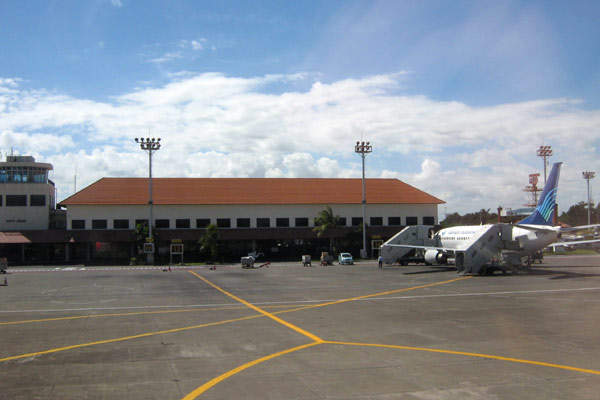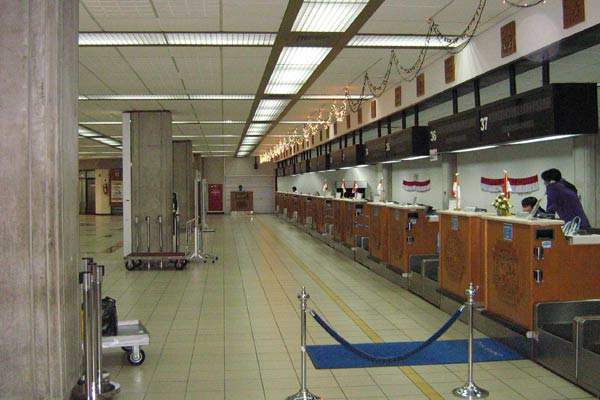
Ngurah Rai International Airport, the only airport in Bali, is located 13km from Denpasar. It is also known as Denpasar or Bali International Airport and is managed by state-owned company PT (Persero) Angkasa Pura I.
The airport is spread over an area of 295.6ha and serves about 12 million passengers per year. Located 2.5km away from the resort of Kuta, it is the third-busiest international airport in Indonesia.
It was originally built in 1931 in the village of Tuban.
The airport earned International Civil Aviation Organization (ICAO) recognition in 1963 and a new international terminal building and runway extension to 2,700m were completed in 1969.
In 1978 another new international terminal building was built and the old building became a domestic terminal.
Phase I in the development plan for the airport from October 1989 to August 1992 included further extension of the runway to 3,000m, a taxiway relocation and expansion of the apron.
Air navigation and fuel supply facilities were also developed, along with a passenger terminal building.
Phase II started in February 1998 and was completed in June 2000. The airport’s aviation facilities were developed during this phase.
A set of flight control facilities was introduced in June 2009.
A new expansion project started in 2010 and completed in September 2013 extended the international terminal increasing the annual passenger handling capacity from 10 million to 25 million.
In May 2009, a design proposed by PT Angkasa Pura I for the expansion of the airport was rejected by the governor of Bali because 40% of all space was designated for commercial use.
In October 2009 another design, which designated 30% of the total area to commercial use, was accepted.
Expansion
The expansion of the airport started in November 2010 after several months of delay. The government spent $187m towards the project.
The programme involved extension of the international and domestic terminals and the expansion of parking lots and other facilities.
The international terminal area was extended from 65,800m² to 120,000m² and the domestic terminal was expanded in size from 13,300m² to 65,800m².
Property developments around the airport included a 485,800m² golf course south of the runway, a 29,200m² trade centre, a 23,000m² hotel and commercial area, and a 4,566m² transshipment cargo area north of the apron.
Terminal features
The airport has one domestic terminal and one international terminal, as well as a cargo building. The older building is used as the domestic terminal while the international terminal is located in a newer, L-shaped building.
The international terminal is comprised of a departure and an arrival terminal. A festival plaza divides the terminals.
The departures terminal has a waiting room and ten boarding gates, each equipped with aviobridges and automatic aircraft parking systems. The boarding rooms can hold 3,175 passengers. The baggage claiming room has 146 conveyors and 62 scale units.
The new international arrivals terminal features 20 Visa on Arrival counters, 26 immigration counters, seven baggage conveyor belts, and three customs and excise counters.
The domestic terminal has a boarding room that can accommodate 2,118 people. The domestic luggage claim room has two L-shaped luggage conveyor units.
Waiting rooms are available for main class passengers at the domestic and international terminals. They can hold about 1,573 passengers. Duty-free shops, restaurants, banks and moneychangers, telephone facilities, hotel reservations counters and tourism information centres are also present.
The international cargo area occupies 2,785m² while the domestic cargo area occupies 952m² and has cold storage.
Runway
Ngurah Rai has a single runway. When the airport was built in 1931 it had a grass runway. A new asphalt runway, 45m wide and 1,600m-long, was constructed between 1941 and 1947.
The current runway is 3,000m long and directed along 09/27. It has an asphalt surface and is made from concrete.
Parking and road infrastructure
The airport has a 55,000m² car park facility with five exit taxiways and two parallel taxiways.
The vehicle parking area measures 61,376m² and can accommodate 48 buses, 306 taxis, 1,002 cars and 711 two-wheelers.
An aircraft parking lot is available for seven class B, 10 DC and 25 class B 737 aircraft. Three helipads are also available.
The parallel taxiways are 278m x 23m and 580m x 23m. Three of the exit taxiways measure 148m x 30m and two measure 232m x 30m.
Security and check-in
The airport was certified as meeting US Government security standards on 11 October 2007.
The decision was based on Transportation Security Administration (TSA) assessments, which concluded that security measures at the airport complied with ICAO standards.
The airport has 17 gates. The domestic terminal has 35 electronic scale check-in counters and two baggage carousels. The international terminal is equipped with a check-in room that houses 62 electronic scale check-in counters.
Air traffic control
A new air traffic control (ATC) system at the airport was among flight control facilities introduced in June 2009.
The area control centre (ACC) in Bali is divided into three sectors: Bali West Control, Bali Centre Control and Bali East Control. All sectors are fully controlled with the help of radar and non-radar. Bali West Control covers position 1140E – Semarang at altitudes from 18,000ft to 46,000ft, where the frequency of radio communications is 123.9MHz. The transmitter is located in Surabaya.
Bali Centre Control is positioned 1140E covering altitudes from 18,000ft to 46,000ft. It has a frequency of 120.7MHz. Bali East Control is also positioned 1140E – Indonesia and Australia border covering altitudes of 18,000ft to 46,000ft. The frequency of this sector is 128.3MHz and the transmitter is located in Kintamani and Waingapu.
The approach control office (APP) controls the aircraft within a 10nm to 60nm radius of the airport between the surface and 2,500ft to 19,000ft by means of full object radar detection.
The aerodrome control tower (ADC) is responsible for efficient movement of vehicles on taxiways and aircraft on the ground and in the air. The ADC has a control radius of 0nm to 5nm (DVOR – BALI as point 0) at altitudes of 0ft to 2,500ft.
Communications and other airport systems
Communication facilities at Ngurah Rai International Airport include aeronautical fixed services (AFS), aeronautical mobile services (AMS) and automatic terminal information services (ATIS).
Standard navigation tools at the airport include primary and secondary surveillance radars, a lighting system, landing strip lighting, a precision approach path indicator (PAPI), approach and threshold lamps, a rotating beacon and a light for identifying the runway’s end.
Maintenance facilities
The fuelling depot, operated by PT (Persero) Pertamina, has six concealed tanks with a total capacity of about 20 million litres.
Ground handling services are controlled by eight companies. In-flight catering is organised by two national companies located at the east of the terminal. A quarantine office is available.




